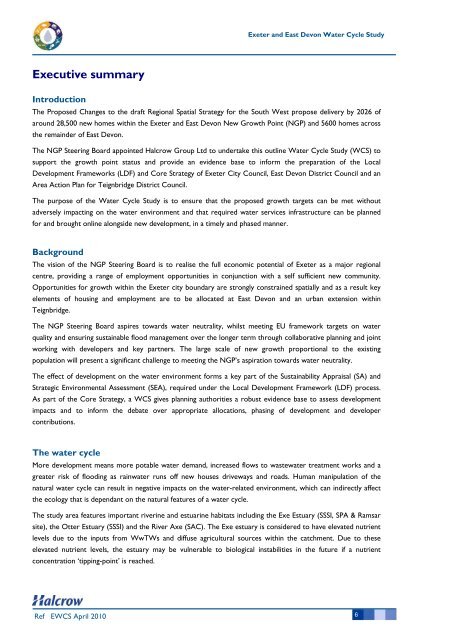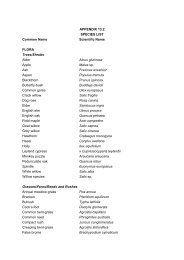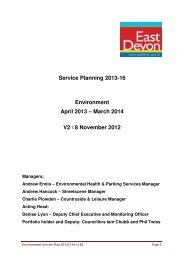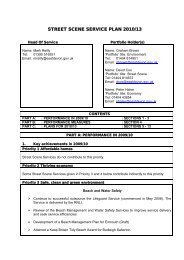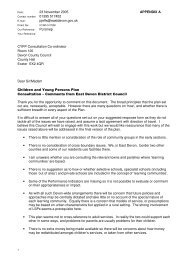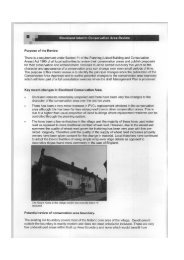Water Cycle Study - East Devon District Council
Water Cycle Study - East Devon District Council
Water Cycle Study - East Devon District Council
Create successful ePaper yourself
Turn your PDF publications into a flip-book with our unique Google optimized e-Paper software.
Executive summary<br />
Introduction<br />
Ref EWCS April 2010<br />
Exeter and <strong>East</strong> <strong>Devon</strong> <strong>Water</strong> <strong>Cycle</strong> <strong>Study</strong><br />
The Proposed Changes to the draft Regional Spatial Strategy for the South West propose delivery by 2026 of<br />
around 28,500 new homes within the Exeter and <strong>East</strong> <strong>Devon</strong> New Growth Point (NGP) and 5600 homes across<br />
the remainder of <strong>East</strong> <strong>Devon</strong>.<br />
The NGP Steering Board appointed Halcrow Group Ltd to undertake this outline <strong>Water</strong> <strong>Cycle</strong> <strong>Study</strong> (WCS) to<br />
support the growth point status and provide an evidence base to inform the preparation of the Local<br />
Development Frameworks (LDF) and Core Strategy of Exeter City <strong>Council</strong>, <strong>East</strong> <strong>Devon</strong> <strong>District</strong> <strong>Council</strong> and an<br />
Area Action Plan for Teignbridge <strong>District</strong> <strong>Council</strong>.<br />
The purpose of the <strong>Water</strong> <strong>Cycle</strong> <strong>Study</strong> is to ensure that the proposed growth targets can be met without<br />
adversely impacting on the water environment and that required water services infrastructure can be planned<br />
for and brought online alongside new development, in a timely and phased manner.<br />
Background<br />
The vision of the NGP Steering Board is to realise the full economic potential of Exeter as a major regional<br />
centre, providing a range of employment opportunities in conjunction with a self sufficient new community.<br />
Opportunities for growth within the Exeter city boundary are strongly constrained spatially and as a result key<br />
elements of housing and employment are to be allocated at <strong>East</strong> <strong>Devon</strong> and an urban extension within<br />
Teignbridge.<br />
The NGP Steering Board aspires towards water neutrality, whilst meeting EU framework targets on water<br />
quality and ensuring sustainable flood management over the longer term through collaborative planning and joint<br />
working with developers and key partners. The large scale of new growth proportional to the existing<br />
population will present a significant challenge to meeting the NGP’s aspiration towards water neutrality.<br />
The effect of development on the water environment forms a key part of the Sustainability Appraisal (SA) and<br />
Strategic Environmental Assessment (SEA), required under the Local Development Framework (LDF) process.<br />
As part of the Core Strategy, a WCS gives planning authorities a robust evidence base to assess development<br />
impacts and to inform the debate over appropriate allocations, phasing of development and developer<br />
contributions.<br />
The water cycle<br />
More development means more potable water demand, increased flows to wastewater treatment works and a<br />
greater risk of flooding as rainwater runs off new houses driveways and roads. Human manipulation of the<br />
natural water cycle can result in negative impacts on the water-related environment, which can indirectly affect<br />
the ecology that is dependant on the natural features of a water cycle.<br />
The study area features important riverine and estuarine habitats including the Exe Estuary (SSSI, SPA & Ramsar<br />
site), the Otter Estuary (SSSI) and the River Axe (SAC). The Exe estuary is considered to have elevated nutrient<br />
levels due to the inputs from WwTWs and diffuse agricultural sources within the catchment. Due to these<br />
elevated nutrient levels, the estuary may be vulnerable to biological instabilities in the future if a nutrient<br />
concentration ‘tipping-point’ is reached.<br />
6


